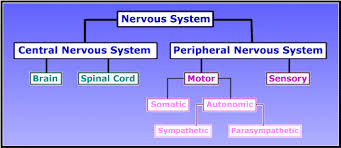Introduction to Neuroanatomy: Difference between revisions
No edit summary |
No edit summary |
||
| Line 4: | Line 4: | ||
'''Top Contributors''' - {{Special:Contributors/{{FULLPAGENAME}}}} | '''Top Contributors''' - {{Special:Contributors/{{FULLPAGENAME}}}} | ||
</div> | </div> | ||
== Overview of the Nervous System == | == Overview of the Nervous System == | ||
The nervous system can be divided into 3 significant parts. | The nervous system can be divided into 3 significant parts. | ||
These are | These are | ||
#Autonomic Nervous System (ANS) | #Autonomic Nervous System (ANS) | ||
#Peripheral Nervous System (PNS) | #Peripheral Nervous System (PNS) | ||
#Central Nervous System (CNS) | #Central Nervous System (CNS) | ||
[[Image:Nstable.jpg|frame|center]]<br> | |||
<u>'''1. Autonomic Nervous System'''</u> | |||
< | The ANS's main role is to innervate the internal and glandular organs. The peripheral component is defined in terms of the '''enteric, sympathetic, and parasympathetic systems.''' | ||
<u>'''2. Peripheral Nervous System'''</u> | |||
The PNS consists of nerve trunks that are formed from both '''afferent axons''' which conduct sensory information to the spinal cord, and '''efferent fibres''' which transmit impulses primarily to muscles. If these a particular nerve is damaged, then there is resulting weakness to the muscle it supplies as well as sensory loss from the region it conveys information from. | |||
The peripheral nerves connect with the spinal cord through foramina in the vertebra of the spine, or with the brain through foramina in the skull. | |||
<u>'''3. Central Nervous System'''</u> | |||
== Sub Heading 2 == | == Sub Heading 2 == | ||
Revision as of 14:55, 22 February 2016
Original Editor - Your name will be added here if you created the original content for this page.
Top Contributors - Joanne Garvey, Lucinda hampton, Naomi O'Reilly, Laura Ritchie, Kim Jackson, Kate Sampson, Rachael Lowe, Tarina van der Stockt, Admin, WikiSysop, Simisola Ajeyalemi, Adam Vallely Farrell, Rucha Gadgil, Rewan Elsayed Elkanafany, Jess Bell, George Prudden, Mande Jooste and Scott Buxton
Overview of the Nervous System[edit | edit source]
The nervous system can be divided into 3 significant parts.
These are
- Autonomic Nervous System (ANS)
- Peripheral Nervous System (PNS)
- Central Nervous System (CNS)
1. Autonomic Nervous System
The ANS's main role is to innervate the internal and glandular organs. The peripheral component is defined in terms of the enteric, sympathetic, and parasympathetic systems.
2. Peripheral Nervous System
The PNS consists of nerve trunks that are formed from both afferent axons which conduct sensory information to the spinal cord, and efferent fibres which transmit impulses primarily to muscles. If these a particular nerve is damaged, then there is resulting weakness to the muscle it supplies as well as sensory loss from the region it conveys information from.
The peripheral nerves connect with the spinal cord through foramina in the vertebra of the spine, or with the brain through foramina in the skull.
3. Central Nervous System
Sub Heading 2[edit | edit source]
Sub Heading 3[edit | edit source]
Recent Related Research (from Pubmed)[edit | edit source]
Extension:RSS -- Error: Not a valid URL: Feed goes here!!|charset=UTF-8|short|max=10
References[edit | edit source]
References will automatically be added here, see adding references tutorial.







